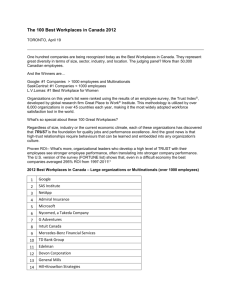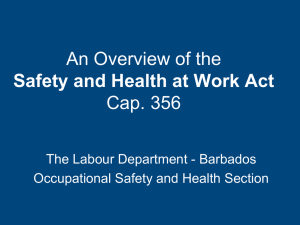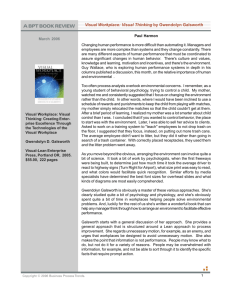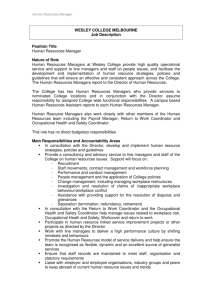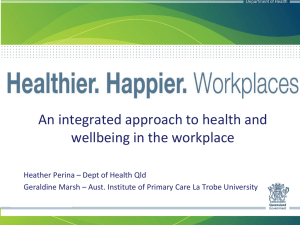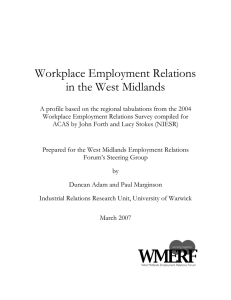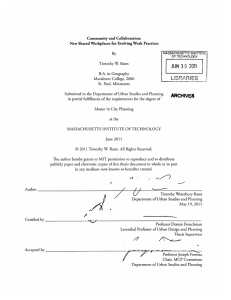World Heath Organisation Europe
advertisement
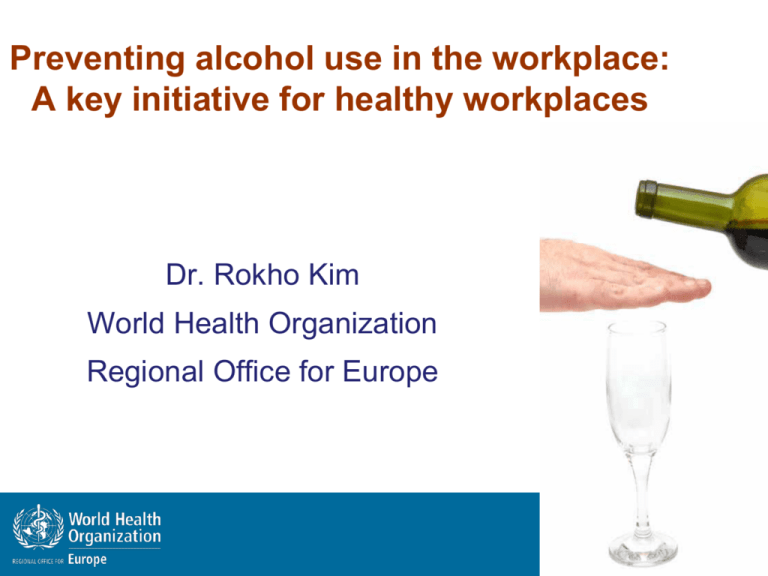
Preventing alcohol use in the workplace: A key initiative for healthy workplaces Dr. Rokho Kim World Health Organization Regional Office for Europe Outline • Introduction • Burden of alcohol-attributable diseases • WHO responses to alcohol challenges • Importance of health and safety at work • Healthy workplaces – holistic paradigm • Concluding remarks Why healthy workplaces? • Workers are half of the whole population • Healthy workforce is a prerequisite for sustainable development and social wellbeing • Preventable consequences – Workers: loss of health and wellbeing – Community: loss of solidarity and equity – Company: loss of productivity and profit – Country: loss of 4-5% of GDP • A major social determinant of health and equity Our target population: 'the global workforce' Most of the world's 2.8 billion workers can benefit from a "healthy workplace" approach, and particularly… – the 1.9 billion workers who are employed in unhealthy & unsafe workplaces…and that include 170 million children – 400 million workers in the WHO European Region Personal health practices (“risk factors”), health costs, and productivity Shain M , Kramer D M Occup Environ Med 2004;61:643-648 6 October 2011 ©2004 by BMJ Publishing Group Ltd Source: Joan Burton. WHO Healthy Workplace Framework and Model, 2010. http://www.who.int/occupational_health/healthy_workplace_framework.pdf Alcohol-attributable disease and injury (1/2) Chronic disease: Cancer: Mouth & oropharyngeal cancer, esophageal cancer, liver cancer, female breast cancer Neuropsychiatric diseases: Alcohol use disorders, unipolar major depression, primary epilepsy Cardiovascular diseases: Hypertensive diseases, hemorrhagic stroke Gastrointestinal diseases: Liver cirrhosis Conditions arising during perinatal period: Low birth weight Alcohol-attributable disease and injury (2/2) Injury: Unintentional injury: Motor vehicle accidents, drownings, falls, poisonings, other unintentional injuries Intentional injury: Self-inflicted injuries, homicide, other intentional injuries Preventive effects: Diabetes Ischemic heart disease Ischemic stroke Deaths among people aged 15–29 years related to selected risk factors, European Region, 2004 Unmet contraceptive needs Child sexual abuse Low fruit/vegetable consumption Iron deficiency Occupational risks Physical inactivity High blood glucose Illicit drug use Unsafe sex Alcohol use 0 20000 40000 Deaths Deaths Men Women 60000 Total disability-adjusted life-years (DALYs) lost due to selected risk factors, European Region, 2004 Global drinking and European drinking 2005 High exposure, high burden of mortality and disease • For men between ages of 15 and 64, 1 in 7 deaths in 2004 were caused by alcohol (clearly premature deaths given the life expectancy in Europe) • For women of the same age category, 1 in 13 deaths in 2004 were caused by alcohol What works in alcohol policy: evidence Degree of evidence Action that reduces alcohol-related harm Action that does not reduce alcoholrelated harm Convincing • Alcohol taxes – • Government monopolies on retail sale • Restrictions on outlet density • Restrictions on days and hours of sale • Minimum purchase age • Lower legal blood alcohol concentration for driving • Random breath-testing • Brief advice programmes • Treatment for alcohol use disorders Probable • Minimum price per gram of alcohol • Lower taxes to manage cross-border trade • Restrictions on the volume of commercial messages • Training of alcohol servers • Enforcement of restrictions on sales to intoxicated and underage people • Consumer labelling and warning messages • Designated driver campaigns • Public education campaigns Limited/ Suggestive • Suspension of driving licences • Alcohol locks • Workplace programmes • Campaigns funded by the alcohol industry Sixty-third World Health Assembly, 17–21 May 2010 Endorsed the global strategy to reduce the harmful use of alcohol in WHA63.13 European action plan to reduce the harmful use of alcohol (EAAP) 2012–2020 – 10 action areas • Leadership, awareness and commitment, as sustainable intersectoral action requires strong leadership and a solid base of awareness and political will • Health services’ response, as these services are central to tackling health conditions in individuals caused by harmful alcohol use • Community action, as governments and other stakeholders can support and empower communities in adopting effective approaches to prevent and reduce harmful alcohol use in both communities and at workplaces • Policies and countermeasures on drink–driving, as it is extremely dangerous to drivers, passengers and other people using the roads • Availability of alcohol, as public health policies to regulate commercial or public availability have proved to be very effective in reducing the general level of harmful use and drinking among minors EAAP 2012–2020 – 10 action areas • Marketing of alcoholic beverages, as systems are needed to protect people, particularly children and young people, from advanced advertising and promotion techniques • Pricing policies, as most consumers, particularly heavy drinkers and young people, are sensitive to changes in the prices of alcohol products • Reducing the negative consequences of drinking and alcohol intoxication, in order to minimize violence, intoxication and harm to intoxicated people • Reducing the public health impact of illicit and informally produced alcohol, as its consumption could have additional negative health consequences due to its higher ethanol content and potential contamination with toxic substances • Monitoring and surveillance, as relevant data create the basis for the appropriate delivery and success of responses New publication, launched on 27 March 2012. Special chapter on Alcohol and the workplace “The workplace provides several opportunities for implementing prevention strategies to reduce the harm done by alcohol, since the majority of adults are employed and spend a significant proportion of their time at work.” Workplace services and legislation WHO survey in EU Member States (2011) No of countries (N=29) Prevention or counselling programmes at workplaces National guidelines for prevention of and counselling for alcohol problems at workplaces 18 8 Involvement of social partners representing employers and employees in action to prevent and address alcohol-related harm at workplaces 11 Legislation on alcohol testing at workplaces 10 Occupational health risks diseases, injuries, deaths • Occupational risks play a big role in chronic diseases: • 26% CVD & chronic pulmonary disease • 15% asthma • 10% cancer • 8% injuries • 8 % depression • 300 000 deaths from work-related diseases in the WHO European Region (4% GDP loss) Health promotion: improved workers' health better performance Workplace-based initiatives can help support, for instance: • Work-lfe bakance • Smoking • Drinking • Obesity control • Cardiovascular health • Exercise & physical activity Enterprise community involvement social & environmental determinants • Safe/healthy access to work – public transport, carpools, walking, cycling • Voluntary pollution/waste control & cleanup • Provision of primary health care and health education unavailable through health care services outside the workplace 60th World Health Assembly, May 2007 Resolution 60.26 "Workers' Health: Global Plan of Action" •The Global Plan of Action developed by the Member States for the Member States •WHA60 endorsed the global plan of action on workers' health (2008-2017) •WHA60 urged Member States to take an number of measures on workers' health WHO Model of Healthy Workplaces Combining health protection & health promotion Developed by leading occupational health experts out of systematic review of literature October 2009 workshop involving 56 experts from 22 countries, international worker & employer representatives 24 Paradigm shift From: Labour approach Occupational health To: Public health approach Workers' health Action at workplace Action to include workers' families & communities Work-related health issues only Include all health determinants Work under labour contract Include all workers (selfemployed, informal workers) Employers' responsibility All stakeholders' responsible (insurance, health & environm. authorities, a.o.) Negotiation between workers and employers Health protection is a nonnegotiable A holistic framework for action 1. Action in four realms: Physical work environment • Physical work Mobilize • Psychosocial environment • Personal health Assemble Improve Psychosocial work environment Leadership engagement Evaluate • Community involvement ETHICS & VALUES Assess Personal health resources Worker involvement Do Prioritize Plan 2. A model of continuous improvement Enterprise community involvement 26 • Eliminate a toxic chemical or substitute with less hazardous • Install machine guards/exhaust ventilation • Train workers on safe operating procedures • Personal protective equipment such as respirators or hard hats 27 Reallocate work to reduce workload Zero tolerance for harassment, bullying, discrimination Respect work-family balance Recognize and reward good performance Meaningful worker input into decisions that affect them 28 • provide fitness facilities, classes or equipment for workers; • provide healthy food choices (e.g., cafeteria) • put no-smoking policies in place, provide smoking cessation assistance; • provide information about alcohol and drugs, and employee assistance counseling As an employer you can create or remove barriers to lifestyle changes! 29 - Free/affordable Primary health care to workers/family members; - Voluntary controls over pollutants released into the air or water; - Financial support to worthwhile community causes; - Minimize greenhouse gas emissions. 30 Crosscutting principles for success • Leadership engagement • Involve workers & their representatives • Do an effective gap analysis • Learn from others • Integrate activities • Evaluate and improve Outlook of WHO is based on its Constiution… Healthy workplaces is inspired by the WHO definition of health as: “a state of complete physical, mental and social wellbeing and not merely the absence of disease or infirmity” WHO constitution, signed on 22 July 1946 by the representatives of 61 States and entered into force on 7 April 1948 32 How to convince the business community 1. The 'right' thing to do: businesses are part of society and ethical/social frameworks 2. The 'legal' thing to do: in our globalized world, businesses that ignore or undermine workers' health are open to litigation and media scrutiny 3. The 'smart' thing to do: businesses that protect workers' health are among the most successful over time Healthy companies are also profitable! For every $ spent: – Medical costs fall by $3.27 – Absenteeism costs fall by $2.73 “The wide adoption of wellbeing programs could prove beneficial for budgets and productivity as well as health outcomes” (Baicker K, et al. Workplace wellness programs can generate savings. Health Affairs, 2010) A holistic framework for action Physical work environment Mobilize Assemble Improve Psychosocial work environment Leadership engagement Evaluate ETHICS & VALUES Assess Personal health resources Worker involvement Do Prioritize Plan Enterprise community involvement 35 Elements of good practices of health workplaces initiative at the company level • • • • • • • • • • • Linking programmes to business objectives Top management support Employee advisory boards Effective communication Supportive environment Use of incentives Goal setting Self-efficacy Social environment, social norms and social support Tailored programmes Building effective programmes across the individual to environment continuum Healthy workplaces model: an integrated approach A comprehensive approach that embraces: • Traditional & emerging occupational health – minimizing workers' exposure to job-related physical & psychosocial risks • Health promotion – promoting healthy behaviours among workers, both job- and lifestyle-related • Enterprise involvement in community – to address broader social & environmental determinants of workers health Together, we can make a difference! Thank you. Acknowledgements: Parts of this presentation were supported by my colleagues, Drs. Lars Moeller and Evelyn Kortum. Email: kimr@who.int www.euro.who.int/alcohol http://www.euro.who.int/en/what-we-do/healthtopics/environment-and-health/occupational-health http://www.who.int/occupational_health/healthy_wor kplaces
